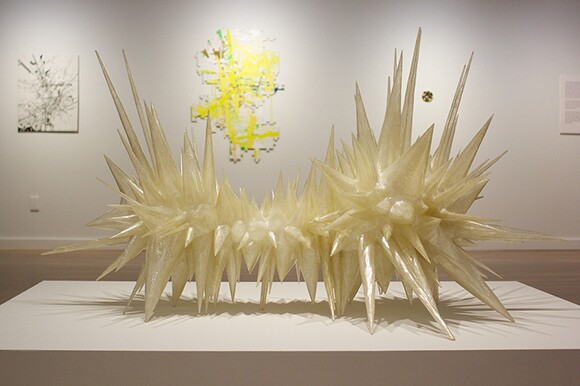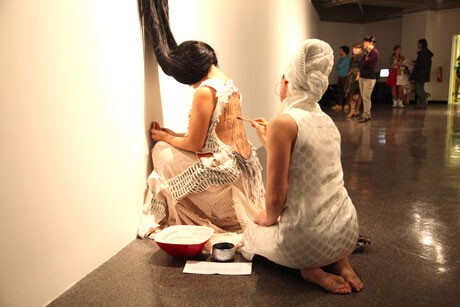"Troubling Borders" Brings Southeast Asian Women to Riverside

"Troubling Borders: Southeast Asian Women in the Diaspora," on view at the Sweeney Art Gallery in downtown Riverside through October 7, showcases writings and visual works by women of Cambodian, Laotian, Filipino and Vietnamese descent and by women who identify as the often stateless Mien, Hmong, and Cham. Such works bear witness to the legacies of displacement and the hauntings of empire that linger to this day. In the aftermath of the cold war, many of these women reside in the United States, Canada, Europe, Australia, and other parts of the world. The exhibition features paintings, drawings, photographs, videos, and sculptures by seven international, contemporary artists: Anida Yoeu Ali, Reanne Estrada, Lin+Lam, Ann Phong, Nalyne Lunati, Hong-An Truong, and Julie Thi Underhill. The writers who will be reading include Leakhena Leng, Karen Llagas and Julie Thi Underhill.

Forming an incredibly diverse group, these women writers and artists point to the ruptures caused by colonization, war, globalization, and militarization. Their stories and artwork are vital and varied, and together they provide a sharp contrast to normative narratives and ideologies that have been constructed in the West and the nation-states of Southeast Asia. The exhibition is curated by Lan Duong, associate professor, Media & Cultural Studies Department, University of California, Riverside, and Isabelle Thuy Pelaud, associate professor, Asian American Studies, San Francisco State University.
"Too often Southeast Asian women are represented as exotic sex symbols and dragon ladies, prostitutes and 'bar girls' in movies and the media," Duong says. "By making these works visible to a large public and pushing the boundaries of literature and art, we demonstrate the global connections that bring these disparate groups of women together."

This multimedia art exhibition and colloquium also previews the contents and celebrates the upcoming publication of the first anthology by and about Southeast Asian women in the diaspora. Four years in the making, "Southeast Asian Women in the Diaspora: Troubling Borders in Literature and Art" is edited by Isabelle Thuy Pelaud, Lan Duong, Mariam B. Lam and Kathy Nguyen and will be published by the University of Washington Press in 2013. According to Duong, "Only a few anthologies, to date, and some educational materials deal with the topics that are covered in this collection." The only other Southeast Asian American anthology, according to Duong, that has been published is "Tilting the Continent," edited by Shirley Geok-lin Lim and Cheng Lok Chua, along with other Asian and Asian American women's anthologies. Collections like "Our Feet Walk the Sky: Women of the South Asian Diaspora," "Dragon Ladies: Asian American Feminists Breathe Fire, Making Waves, Making More Waves," and "Virtual Lotus" have also been ground-breaking in creating and reinforcing a need for the publication and circulation of women's writings.

By making these works visible to a large public and pushing the boundaries of literature and art, the editors want to continue in these collections' legacy and further highlight the global connections that draw many disparate groups of women together.
Artists in the Exhibition
Performance artist, writer and global agitator, Anida Yoeu Ali is a first generation Muslim Khmer woman born in Cambodia and raised in Chicago. She has written that her "interdisciplinary performances use Butoh to examine the poetic potential of the body and collective healing." Inspired by a scene in Maxine Hong Kingston's memoir "The Woman Warrior," Ali's performance in her three-channel video installation -- "Palimpsest for Generation 1.5," which documents an original performance and installation in 2009 -- includes inscriptions written onto her back and the gesture of washing them away. Considering her own work, she says, "embodying the archetype of the universal mother/woman warrior figure who nurtures despite witnessing violence and atrocities," she sits exposed and faceless. In the performance, her body is transformed into a palimpsest where histories are inscribed, one moment layered over another.

Born in Manila, Philippines, Reanne Estrada is a Los Angeles-based visual artist who makes works that uses everyday materials that become mimics of other objects: Ivory soap passes as ivory, erasers for smooth stones, wax or candy, packing tape for crystalline formations. She says, "They pay homage to the horror of beauty, defined as the threat of its loss, and embrace contradictory impulses." In "II. One Thousand, One Hundred Eight," 1998, the work is composed of hair on Ivory soap, laid in delicate, geometric lines on the soap, and treated as a reliquary in shadowbox on terry cloth-covered pedestal. Her work alludes to the fragility of the body and serves as a metaphor for the mutable, unstable nature of identity.

Lin + Lam produce research-based projects that examine how individual and national subjectivities are mediated and defined. Lin + Lam write that they "investigate the contested relationship between Vietnam and the U.S., and counter mainstream media by asking viewers to redefine the ways historical understanding is constructed." In the video, the directors mine the material artifacts of the archive, fingering deteriorating film labels and paging through catalogue lists. "Unidentified Vietnam No. 18" is a successor to the seventeen films in the Library of Congress South Vietnam Embassy Collection labeled only "Unidentified Vietnam, # 1-17." Initiated by these 1960s propaganda films, the project calls into question the policies and politics of nation-building.

Ann Phong was born in Saigon. In 1981 she had a chance to escape Vietnam by boat, and has since settled down in Southern California. Seawater inspires her. Its transparency underneath the bright sun allows her to see different depths in it. As she says, "I have crossed the Pacific Ocean from one end to the other many decades ago. That journey has left a colorful imprint on my life." In paintings, such as "Boats,"1998 vessels are recurring images. Vessels have a long tradition of being stand-ins for women in art history, but in Phong's art, boats are also references to immigrants and the label of "Boat people," a classification that American newspapers and magazines conjured three decades ago, when Vietnamese refugees escaped communism by fleeing on small boats.

Nalyne Lunati is a Thai American artist. Born in Bangkok, Thailand in 1972, she immigrated with her parents to the United States when she was 5 years old. She grew up in Arcadia, California. In paintings such as "Vihara of the Mind," 2006, Lunati treats the artistic process as a ritualized one that provides an avenue for exploring the depths of one's soul. Although she works abstractly, the source of her iconography comes from seeing images while traveling the world. In addition to a fine arts education, her academic background also includes studies in Political Economy of Industrial Societies, Business Administration, Southeast Asian Studies, Anthropology, and foreign languages. As she says, "These influences and life experiences inform her work conceptually and thematically, creating thought-provoking and technically well executed artwork."

Hong-An Truong is an artist and writer based in New York and North Carolina. She has been an artist-in-residence at the Center for Photography at Woodstock and the Visual Studies Workshop. The video work, "The Past is a Distant Colony and Explosions in the Sky (?iá»?n Biên Ph? 1954)," 2007, is part of a larger project called "Adaptation Fever," which includes four-single channel videos. For Truong, these videos approach the archive through appropriation and disruption, using a doubling device where colonial sounds and scenes are mirrored and juxtaposed against each other. Using found footage of Vietnam during French colonialism, this project explores questions about the politics of representation and the construction of identity and difference in relation to history, time, and memory. Truong says, "The split screen and juxtaposition become a simple technique whereby the 'real' and by extension, its historical referent, are permanently deferred objects, further diminished through the overdubbed narratives in Vietnamese and French, which are only tersely summarized in either English subtitles or not at all."

Julie Thi Underhill is a writer, photographer, filmmaker, historian, and visual artist. Her poetry, essays, and oral histories have been published in "Takin' It to the Streets: A Sixties Reader," "Veterans of War, Veterans of Peace," and "Embodying Asian/American Sexualities." In her black and white photographs, Underhill explores the remnants of violence and grief, but finds that there are few outlets for such expressions. As she writes, "So I take them up in my work. 'Fear of Ambivalence' and 'Grandma' address fear and mourning, respectively, during my first trip to Viet Nam in 1999." Her grandmother's impending death motivated that particular visit.
There will be a closing reception and reading on Saturday, October 6, 6-9 p.m., free admission. Readings by poets and writers from the anthology, "Southeast Asian Women in the Diaspora: Troubling Borders in Literature and Art," include Karen Llagas, Leakhena Leng, and Julie Thi Underhill. On the following day, there will be a colloquium, Sunday, October 7, 1-3 p.m., free admission, which will includes additional artists, scholars and writers from the anthology who will discuss issues of community, craft and reception. It will be moderated by Lan Duong, Isabelle Thuy Pelaud, and Mariam B. Lam.
For further information on "Troubling Borders: Southeast Asian Women in the Diaspora", visit the UCR Sweeney Art Gallery website.
Dig this story? Sign up for our newsletter to get unique arts & culture stories and videos from across Southern California in your inbox. Also, follow Artbound on Facebook and Twitter.


